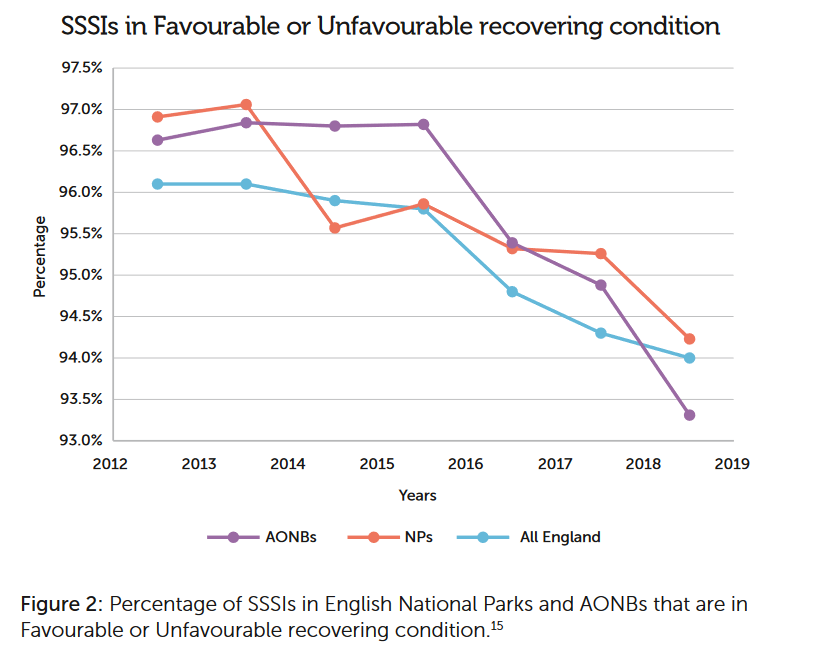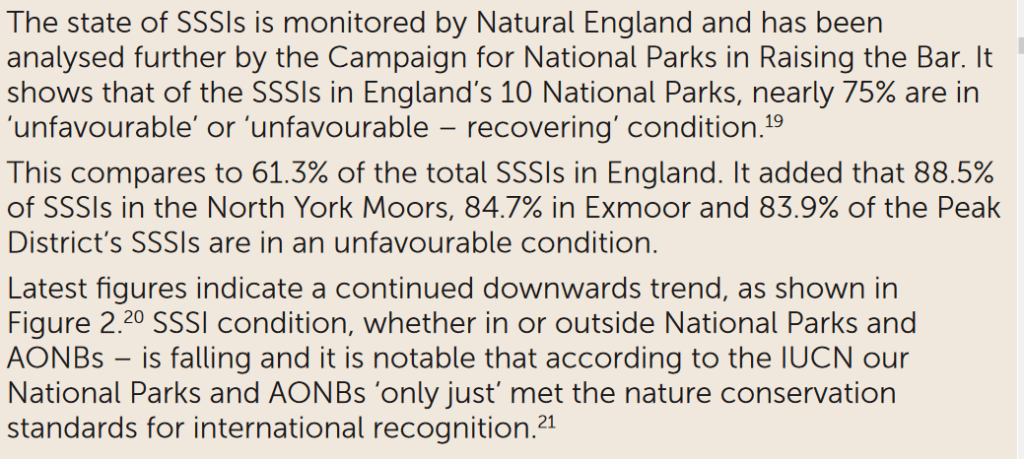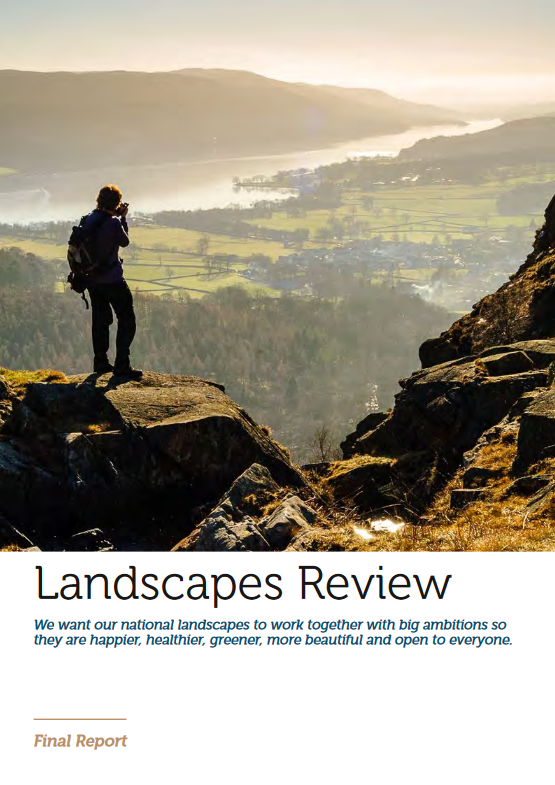How can I possibly be disappointed with the Glover review when it gives nature top-billing (depending on how you read the report) and contains many useful passages such as those below?
In our call for evidence, the message was clear: more than any other single thing, people and organisations agreed that our landscapes should do more for nature.
National Landscapes should be special places for nature. They should lead the way to nature recovery, in line with the 25 Year Environment Plan.
We want a new commitment to recovery which puts natural beauty at its core to make all these places special. They should be exemplars of the very best, improving not degrading. They should look and feel special. Even if we only managed to restore diminished biodiversity to levels taken for granted in 1949 when the law to create National Parks and AONBs was established, we would have achieved something extraordinary.
National landscapes should have a renewed mission to recover and enhance nature.
The state of nature and natural capital in our national landscapes should be regularly and robustly assessed, informing the priorities for action.
This is all good stuff and no-one will disagree with it – in fact no-one has ever disagreed with it it’s just that they haven’t done it either.
One proposed change to the statutory duties and purposes of National Parks is to go from this:
Conserve and enhance natural beauty, wildlife and cultural heritage
to this:
Recover, conserve and enhance natural beauty, biodiversity and natural capital, and cultural heritage
Well, OK, but I’d be surprised if that does it!
The review does not express anything but a tepidly weak view on rewilding – indeed I can’t find the word in its 168 pages although ‘wilder areas’ are sometimes mentioned. The message is basically that we can have, maybe, some ‘wilder’ areas but they’ll have to fit in around what landowners want and they’ll probably be small. This amounts to close to ecological illiteracy from the review panel. Some rewilded areas, in both upland and lowland areas, would be fantastic ways to deliver natural capital and also public education as the different habitats and their wildlife developed. This does not mean having Wolves walking through the streets of Kendal (but if they did I’d be spending my tourist pounds there for the first time in years) but where are the mentions of Beavers, Red Squirrels and Pine Martens?
Come to that, where is the vision for more wild flower meadows as a major component of National Parks and AONBs? And where is the ambition to recover farmland birds, farmland insects and farmland plants in these protected areas?
I wasn’t expecting much on grouse moors here, even though they are a very high component of the land area of northern AONBs and National Parks but this passage demonstrates the lack of a professional nature conservation expert on the panel;
Moors are a feature of many National Parks and AONBs and many are managed for shooting. In the course of this review, we have been left in no doubt about the controversy this causes. This is not the place to set out a firm answer here. We respect the passion on both sides but note that both have one interest at heart: healthy moors, with good biodiversity. Well‑managed moors can achieve that and overcome past mistakes such as the draining of uplands, mostly encouraged not by grouse management but by government. We shouldn’t blame all failings on shooting interests, but nor can that excuse owners and managers from bad management or the lack of species which one would expect to see in the upland landscape. A balance is the way forward.
The composition of the review group made this type of lazy analysis more than likely to feature. Past and current mistakes such as over-burning of blanket bogs and, yes, drainage, can be put firmly at the door of grouse moor managers. And ‘the lack of species one might expect to see in the upland landscape’ is a phrase wilfully blind to the level of wildlife crime emanating from grouse shooting. It is ironic that the Glover review was published on the same weekend as police forces across the UK were promoting Operation Owl and the need to crack down on crime against birds of prey as a priority. The Glover review looks the other way and this is unworthy of such a review. Oh well, never mind. A balance of damaging management and ongoing wildlife crime is fine for our most-treasured National Landscapes apparently according to this review group.
But, moving on, this graph is fascinating;

…showing as it does that things are getting worse rather than better. It suggests that over 90% of SSSIs are either in good nick or are getting better. Many readers of the report will find the message above a little difficult to reconcile with the information given a little below;

…which states that most SSSIs are in poor nick or getting better. The apparent contradiction is explained by the fact (and obscurely explained by the text in the report) that overwhelmingly SSSIs in our protected areas (for heavens sake!) are in the unfavourable recovering category and that too often means ‘recovering’ on paper but not recovering in reality. This is the one place where the report really attempts to show us some analysis of the state of nature in National Parks and it mangles it as being too difficult.
There are other places too, such as near the beginning of this report;
There is much debate, and not enough data to say for certain, whether the state of nature in national landscapes is better, or no better, or even worse than it is elsewhere. In the end, this is a fruitless discussion. While it is good news that in a small, heavily populated and very urban island we have retained places of great natural beauty, sometimes alive with wild species – which the policies and staff of our national landscapes have been instrumental in – what can be agreed is that what we currently have is not good enough. That the natural beauty which led to their protection in the first place is being lost.
https://assets.publishing.service.gov.uk/government/uploads/system/uploads/attachment_data/file/833163/landscapes-review-final-report.pdf
This is a massive cop out and an area where a different review panel would have had much more to say. Yes, Glover and his team say that things should be better measured in future but the analysis of current problems is poor.
Because there is no hard analysis of hard data here there is no description of hard need for hard action. Glover does not describe the problem well enough to grope towards a clear vision of a solution. It stops at ‘everyone agrees that we need more nature’ and I’m sure they will, but leaving it at that very high level moves the debate on not at all.
What should Glover have said then? It should have said that grasping rewilding in a sensible way would be a good thing but not the only thing to do and then set out what that sensible way is for National Landscapes and National Parks. And the sensible way is for natural regeneration of flood-preventing, carbon-storing, wildlife-enriching trees to recreate parts of a more natural tree-line in upland National Parks to demonstrate what the underlying ecology would produce – this doesn’t include the immediate scrubbing up of your most cherished Yorkshire dale. And it should include the return of Pine Martens and Red Squirrels to forests in southern England although not the immediate release of Wolves in the High Weald AONB. And it should include the presence of wonderful meadows as a feature of all of these National Landscapes and National Parks, and the ability to hear the buzz of insects and the song of birds. But the vision is fuzzy because the Glover panel is nature friendly but they aren’t nature knowledgable. It really doesn’t look as though this panel spent much time talking to nature professionals about the future of wildlife in these areas because surely if they had then rather than the blandness on offer they would have come up with a tighter more challenging future. After all ‘the message [from consultees] was clear: more than any other single thing, people and organisations agreed that our landscapes should do more for nature‘ and that’s what Glover says but he and his panel did not take this idea very far at all. That’s why it is disappointing. It is a lost opportunity.
[registration_form]
Very pleased to see Emma Marsh’s (RSPB England Director) response to the Glover Report. Do I detect a change in language and emphasis under the new structure?
Is one person’s Natural Beauty another’s untidy mess or vice versa.?
If the review considered the needs of the population in the future they managed to hide it well. I infer from “Our countryside will end up being irrelevant to the country that actually exists” that they do understand a little of what the future may hold – but they ducked talking about it further.
I was disappointed not to find a recipe for courgette chutney.
Filbert – that was one of the saddest things, I agree.